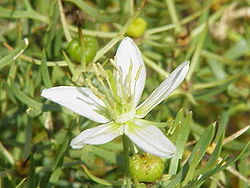| Peganum | |
|---|---|
 | |
| Syrian rue ( Peganum harmala ) | |
| Scientific classification | |
| Kingdom: | Plantae |
| Clade: | Tracheophytes |
| Clade: | Angiosperms |
| Clade: | Eudicots |
| Clade: | Rosids |
| Order: | Sapindales |
| Family: | Nitrariaceae |
| Genus: | Peganum L. |
| Species | |
See text | |
Peganum L. is a genus under the recently separated family Nitrariaceae. [1] Formerly it used to be included in the family Zygophyllaceae.